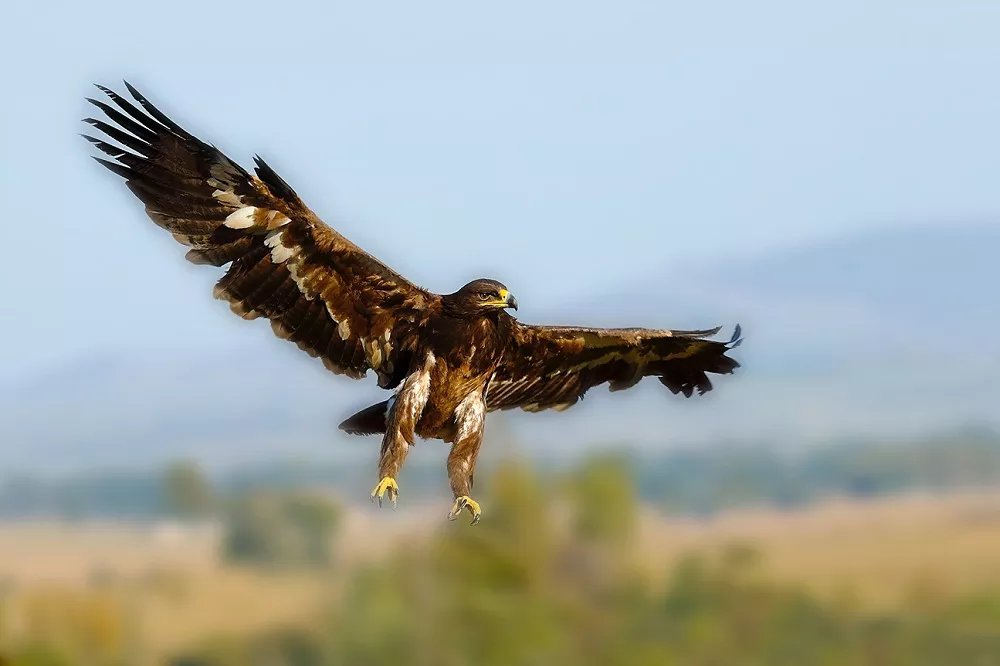Golden eagles (Aquila chrysaetos) are majestic birds of prey known for their impressive hunting skills and powerful flight. As apex predators, golden eagles have a diverse diet that allows them to thrive in various habitats across their range. In this article, we will explore the feeding habits of golden eagles, delving into their preferred prey species, hunting techniques, and the ecological significance of their diet.
1. Range and Habitat:
Golden eagles inhabit diverse ecosystems across North America, Europe, Asia, and parts of northern Africa. They can be found in mountainous regions, grasslands, tundra, and even deserts. Their adaptability to different habitats contributes to the variety of prey they consume.
2. Carnivorous Diet:
Golden eagles are primarily carnivores, feeding on a wide range of animals. Their diet includes small mammals, birds, reptiles, and occasionally, carrion. The composition of their diet varies depending on factors such as geographic location, prey availability, and seasonal changes.
3. Preferred Prey:
The staple food for golden eagles consists of medium-sized mammals, with rodents being a significant component of their diet. Voles, ground squirrels, rabbits, and hares are commonly targeted by these raptors. Additionally, golden eagles are known to hunt larger mammals, including foxes and fawns, using their formidable hunting skills.
4. Avian Prey:
Golden eagles are capable hunters of birds, particularly those of medium size. They often target waterfowl, grouse, pheasants, and other ground-dwelling birds. In some regions, golden eagles have been observed preying on colonial nesting seabirds, such as gulls and cormorants, opportunistically supplementing their diet.
5. Reptiles and Amphibians:
While less common, golden eagles occasionally consume reptiles and amphibians. Snakes, lizards, turtles, and frogs are among the potential prey items in their diet. However, these make up a smaller proportion of their overall food intake compared to mammals and birds.
6. Scavenging Behavior:
Golden eagles are not exclusively hunters; they also scavenge carrion when the opportunity arises. They readily feed on carcasses of large mammals, such as deer or livestock. This scavenging behavior provides an additional source of nourishment for golden eagles during times when hunting is challenging or prey availability is limited.
7. Hunting Techniques:
Golden eagles employ different hunting strategies depending on their prey and habitat. Their most common hunting method involves soaring at great heights, scanning the ground for potential targets. Once prey is spotted, they dive steeply toward it with incredible speed, utilizing their sharp talons to seize and kill their quarry swiftly.
8. Nesting and Feeding Young:
During the breeding season, golden eagles focus on providing food for their offspring. Both parents participate in hunting and feeding duties to sustain their growing chicks. The diet of nestlings primarily consists of small mammals and birds, ensuring a high protein intake necessary for their rapid growth and development.
9. Ecological Significance:
Golden eagles play a vital role in maintaining the balance of various ecosystems. By preying on rodents, they help control their populations and limit potential damage to crops and vegetation. Additionally, their predation on weak or diseased individuals contributes to the overall health of prey populations, promoting robust genetics and minimizing the spread of diseases.
Conclusion:
The diet of golden eagles is characterized by its versatility and adaptability. These magnificent birds demonstrate remarkable hunting skills and consume a diverse array of prey, including mammals, birds, reptiles, and carrion. Their feeding habits not only sustain them but also contribute to the ecological balance of their respective habitats.
FAQs About the Golden Eagle Diet
Q1: What do golden eagles primarily eat?
A1: Golden eagles primarily eat small mammals, including rabbits, hares, and ground squirrels. They also target medium-sized mammals like foxes and, on occasion, young deer. Their diet mainly consists of animal flesh, as they are carnivorous birds of prey.
Q2: Do golden eagles eat birds as well?
A2: Yes, golden eagles are known to include birds in their diet. While birds are not their primary food source, they are skilled at capturing birds in flight. Their avian prey may include waterfowl, game birds, and even other raptors.
Q3: How do golden eagles hunt for their prey?
A3: Golden eagles are adept hunters with excellent aerial skills. They use their keen eyesight to spot potential prey from great distances. Once a suitable target is identified, they employ various hunting techniques, such as stooping (a rapid dive from great heights), soaring, and hovering, to swiftly close in on their prey and make a precise strike.
Q4: Does the golden eagle’s diet vary with the seasons?
A4: Yes, the golden eagle’s diet can exhibit seasonal variations influenced by factors such as migratory patterns of prey species and changes in environmental conditions. During the breeding season, they may focus more on small mammals to feed their young, while in winter, they might rely more on larger mammals or birds as small mammal populations decrease.
Q5: How much food does a golden eagle need in a day?
A5: The amount of food a golden eagle needs in a day can vary based on factors such as its age, size, and activity level. On average, an adult golden eagle may consume around 400 to 600 grams (14 to 21 ounces) of food daily, but this can fluctuate depending on prey availability and nutritional requirements.


 Facebook
Facebook  Instagram
Instagram  Youtube
Youtube 